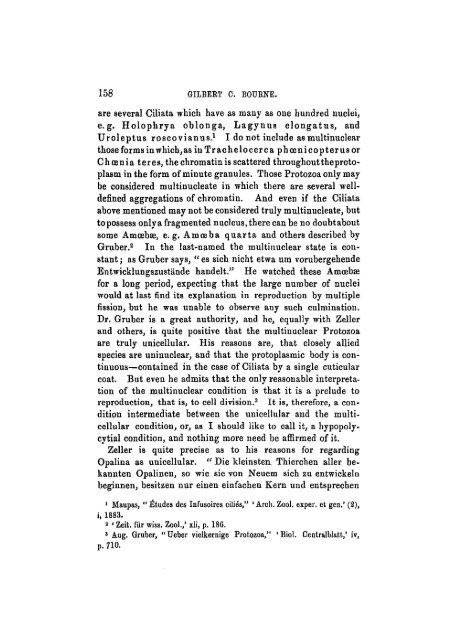A Criticism of the Cell-Theory; being an Answer to Mr. Sedgwick's ...
A Criticism of the Cell-Theory; being an Answer to Mr. Sedgwick's ...
A Criticism of the Cell-Theory; being an Answer to Mr. Sedgwick's ...
Create successful ePaper yourself
Turn your PDF publications into a flip-book with our unique Google optimized e-Paper software.
158 GILBERT 0. BOURNE.<br />
are several Ciliata which have as m<strong>an</strong>y as one hundred nuclei,<br />
e.g. Holophrya oblonga, Lagynus elongatus, <strong>an</strong>d<br />
Uroleptus roacovi<strong>an</strong>us. 1 I do not include as multinuclear<br />
thoseformsinwhich,asiuTrachelocerca phoeni copter us or<br />
Chcenia teres, <strong>the</strong> chromatin is scattered throughout<strong>the</strong>pro<strong>to</strong>plasm<br />
in <strong>the</strong> form <strong>of</strong> minute gr<strong>an</strong>ules. Those Pro<strong>to</strong>zoa only may<br />
be considered multinucleate in which <strong>the</strong>re are several welldefined<br />
aggregations <strong>of</strong> chromatin. And even if <strong>the</strong> Ciliata<br />
above mentioned may not be considered truly multinucleate, but<br />
<strong>to</strong> possess onlya fragmented nucleus,<strong>the</strong>re c<strong>an</strong> be no doubtabout<br />
some Amoebae, e.g. Amoeba quarta <strong>an</strong>d o<strong>the</strong>rs described by<br />
Gruber. 2 In <strong>the</strong> last-named <strong>the</strong> multinuclear state is const<strong>an</strong>t<br />
; as Gruber says, " es sich nicht etwa urn vorubergehende<br />
Entwicklungszust<strong>an</strong>de h<strong>an</strong>delt." He watched <strong>the</strong>se Amoebae<br />
for a long period, expecting that <strong>the</strong> large number <strong>of</strong> nuclei<br />
would at last find its expl<strong>an</strong>ation in reproduction by multiple<br />
fission, but he was unable <strong>to</strong> observe <strong>an</strong>y such culmination.<br />
Dr. Gruber is a great authority, <strong>an</strong>d he, equally with Zeller<br />
<strong>an</strong>d o<strong>the</strong>rs, is quite positive that <strong>the</strong> multinuclear Pro<strong>to</strong>zoa<br />
are truly unicellular. His reasons are, that closely allied<br />
species are uninuclear, <strong>an</strong>d that <strong>the</strong> pro<strong>to</strong>plasmic body is continuous—contained<br />
in <strong>the</strong> case <strong>of</strong> Ciliata by a single cuticular<br />
coat. But even he admits that <strong>the</strong> only reasonable interpretation<br />
<strong>of</strong> <strong>the</strong> multinuclear condition is that it is a prelude <strong>to</strong><br />
reproduction, that is, <strong>to</strong> cell division. 3 It is, <strong>the</strong>refore, a condition<br />
intermediate between <strong>the</strong> unicellular <strong>an</strong>d <strong>the</strong> multicellular<br />
condition, or, as I should like <strong>to</strong> call it, a hypopolycytial<br />
condition, <strong>an</strong>d nothing more need be affirmed <strong>of</strong> it.<br />
Zeller is quite precise as <strong>to</strong> his reasons for regarding<br />
Opalina as unicellular. " Die kleinsten. Thierchen aller bek<strong>an</strong>nten<br />
Opalinen, so wie sie von Neuem sich zu entwickeln<br />
beginnen, besitzen nur einen einfachen Kern und entsprechen<br />
1 Maupas, "Etudes des Infusoires cilies," 'Arch. Zool. exper. et gen.' (2),<br />
i, 1883.<br />
2 ' Zeit. fur wiss. Zool.,' xli, p. 186.<br />
' Aug. Gruber, "Ueber vielkernige Pro<strong>to</strong>zoa," 'Biol. Centralblatt,' iv,<br />
p. 710.
















